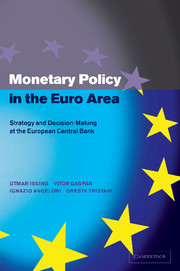Book contents
- Frontmatter
- Contents
- List of figures
- List of tables
- Acknowledgements
- Introduction
- 1 Money, output and prices: the scope of monetary policy
- 2 Monetary policy making: strategies and rules
- 3 The euro area: an overview
- 4 The ECB strategy: defining price stability
- 5 The role of money
- 6 A broadly based assessment
- 7 The ECB strategy: an overall view
- 8 The operational framework
- 9 Accountability and transparency
- 10 The single monetary policy in 1999
- Appendix Excerpts from ECB external communications to the press
- References
- Index
8 - The operational framework
Published online by Cambridge University Press: 22 September 2009
- Frontmatter
- Contents
- List of figures
- List of tables
- Acknowledgements
- Introduction
- 1 Money, output and prices: the scope of monetary policy
- 2 Monetary policy making: strategies and rules
- 3 The euro area: an overview
- 4 The ECB strategy: defining price stability
- 5 The role of money
- 6 A broadly based assessment
- 7 The ECB strategy: an overall view
- 8 The operational framework
- 9 Accountability and transparency
- 10 The single monetary policy in 1999
- Appendix Excerpts from ECB external communications to the press
- References
- Index
Summary
Like every modern central bank, the Eurosystem operates in the financial market to implement monetary policy. The ‘operational framework’, described in this chapter, comprises the overall set of instruments, procedures and practices that are used by the Eurosystem to intervene in the financial market, in order to achieve its objectives as defined by the monetary policy strategy. It is the ‘tool kit’ (interpreted in a broad sense, as we shall see) through which monetary policy is implemented.
The operational framework is clearly linked to, and must be consistent with, the monetary policy strategy. However, the link is not simple or rigid. Different sets of operational instruments and procedures could, in principle, be compatible with the price stability goal. It thus follows that the relative merits of alternative frameworks must be judged not only on the basis of whether they fulfil the goals and requirements of the strategy, but also on market related grounds.
In the case of the Eurosystem, a link between the operational framework and the strategy follows from the principle (established at an early stage by EMI, 1997a, b, c) that the implementation of monetary policy in the euro area would be based on the control of a (suitably defined) short term interest rate (or set of rates). Therefore, a key requirement of the Eurosystem's operational framework must be its ability to ensure good control and signalling properties with respect to short term interest rates.
- Type
- Chapter
- Information
- Monetary Policy in the Euro AreaStrategy and Decision-Making at the European Central Bank, pp. 112 - 127Publisher: Cambridge University PressPrint publication year: 2001



